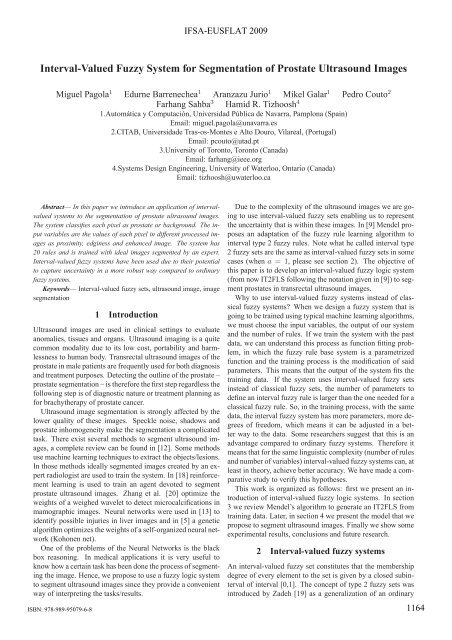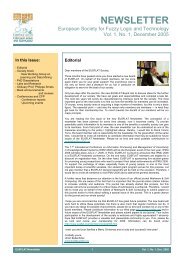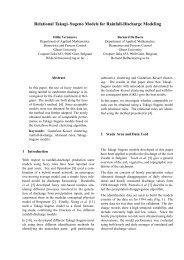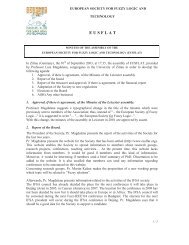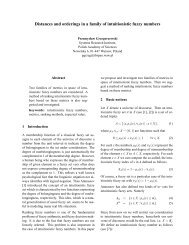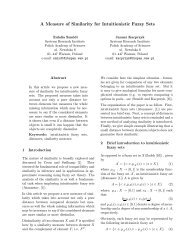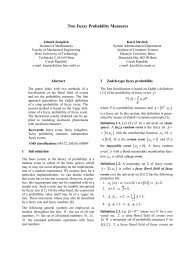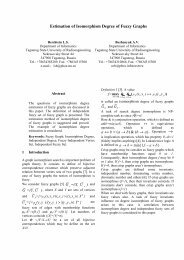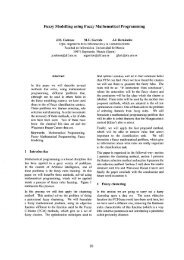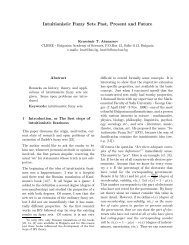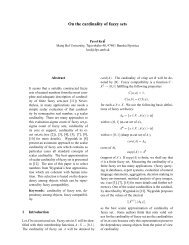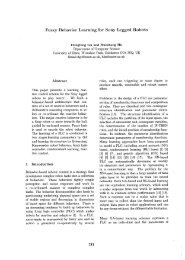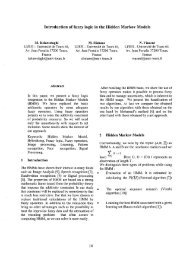Interval-Valued Fuzzy System for Segmentation of ... - EUSFLAT
Interval-Valued Fuzzy System for Segmentation of ... - EUSFLAT
Interval-Valued Fuzzy System for Segmentation of ... - EUSFLAT
Create successful ePaper yourself
Turn your PDF publications into a flip-book with our unique Google optimized e-Paper software.
<strong>Interval</strong>-<strong>Valued</strong> <strong>Fuzzy</strong> <strong>System</strong> <strong>for</strong> <strong>Segmentation</strong> <strong>of</strong> Prostate Ultrasound Images<br />
Miguel Pagola 1 Edurne Barrenechea 1 Aranzazu Jurio 1 Mikel Galar 1 Pedro Couto 2<br />
Farhang Sahba 3 Hamid R. Tizhoosh 4<br />
1.Automática y Computación, Universidad Pública de Navarra, Pamplona (Spain)<br />
Email: miguel.pagola@unavarra.es<br />
2.CITAB, Universidade Tras-os-Montes e Alto Douro, Vilareal, (Portugal)<br />
Email: pcouto@utad.pt<br />
3.University <strong>of</strong> Toronto, Toronto (Canada)<br />
Email: farhang@ieee.org<br />
4.<strong>System</strong>s Design Engineering, University <strong>of</strong> Waterloo, Ontario (Canada)<br />
Email: tizhoosh@uwaterloo.ca<br />
Abstract— In this paper we introduce an application <strong>of</strong> intervalvalued<br />
systems to the segmentation <strong>of</strong> prostate ultrasound images.<br />
The system classifies each pixel as prostate or background. The input<br />
variables are the values <strong>of</strong> each pixel in different processed images<br />
as proximity, edginess and enhanced image. The system has<br />
20 rules and is trained with ideal images segmented by an expert.<br />
<strong>Interval</strong>-valued fuzzy systems have been used due to their potential<br />
to capture uncertainty in a more robust way compared to ordinary<br />
fuzzy systems.<br />
Keywords— <strong>Interval</strong>-valued fuzzy sets, ultrasound image, image<br />
segmentation<br />
1 Introduction<br />
Ultrasound images are used in clinical settings to evaluate<br />
anomalies, tissues and organs. Ultrasound imaging is a quite<br />
common modality due to its low cost, portability and harmlessness<br />
to human body. Transrectal ultrasound images <strong>of</strong> the<br />
prostate in male patients are frequently used <strong>for</strong> both diagnosis<br />
and treatment purposes. Detecting the outline <strong>of</strong> the prostate –<br />
prostate segmentation – is there<strong>for</strong>e the first step regardless the<br />
following step is <strong>of</strong> diagnostic nature or treatment planning as<br />
<strong>for</strong> brachytherapy <strong>of</strong> prostate cancer.<br />
Ultrasound image segmentation is strongly affected by the<br />
lower quality <strong>of</strong> these images. Speckle noise, shadows and<br />
prostate inhomogeneity make the segmentation a complicated<br />
task. There exist several methods to segment ultrasound images,<br />
a complete review can be found in [12]. Some methods<br />
use machine learning techniques to extract the objects/lesions.<br />
In those methods ideally segmented images created by an expert<br />
radiologist are used to train the system. In [18] rein<strong>for</strong>cement<br />
learning is used to train an agent devoted to segment<br />
prostate ultrasound images. Zhang et al. [20] optimize the<br />
weights <strong>of</strong> a weighed wavelet to detect microcalcifications in<br />
mamographic images. Neural networks were used in [13] to<br />
identify possible injuries in liver images and in [5] a genetic<br />
algorithm optimizes the weights <strong>of</strong> a self-organized neural network<br />
(Kohonen net).<br />
One <strong>of</strong> the problems <strong>of</strong> the Neural Networks is the black<br />
box reasoning. In medical applications it is very useful to<br />
know how a certain task has been done the process <strong>of</strong> segmenting<br />
the image. Hence, we propose to use a fuzzy logic system<br />
to segment ultrasound images since they provide a convenient<br />
way <strong>of</strong> interpreting the tasks/results.<br />
ISBN: 978-989-95079-6-8<br />
IFSA-<strong>EUSFLAT</strong> 2009<br />
Due to the complexity <strong>of</strong> the ultrasound images we are going<br />
to use interval-valued fuzzy sets enabling us to represent<br />
the uncertainty that is within these images. In [9] Mendel proposes<br />
an adaptation <strong>of</strong> the fuzzy rule learning algorithm to<br />
interval type 2 fuzzy rules. Note what he called interval type<br />
2 fuzzy sets are the same as interval-valued fuzzy sets in some<br />
cases (when a =1, please see section 2). The objective <strong>of</strong><br />
this paper is to develop an interval-valued fuzzy logic system<br />
(from now IT2FLS following the notation given in [9]) to segment<br />
prostates in transrectal ultrasound images.<br />
Why to use interval-valued fuzzy systems instead <strong>of</strong> classical<br />
fuzzy systems? When we design a fuzzy system that is<br />
going to be trained using typical machine learning algorithms,<br />
we must choose the input variables, the output <strong>of</strong> our system<br />
and the number <strong>of</strong> rules. If we train the system with the past<br />
data, we can understand this process as function fitting problem,<br />
in which the fuzzy rule base system is a parametrized<br />
function and the training process is the modification <strong>of</strong> said<br />
parameters. This means that the output <strong>of</strong> the system fits the<br />
training data. If the system uses interval-valued fuzzy sets<br />
instead <strong>of</strong> classical fuzzy sets, the number <strong>of</strong> parameters to<br />
define an interval fuzzy rule is larger than the one needed <strong>for</strong> a<br />
classical fuzzy rule. So, in the training process, with the same<br />
data, the interval fuzzy system has more parameters, more degrees<br />
<strong>of</strong> freedom, which means it can be adjusted in a better<br />
way to the data. Some researchers suggest that this is an<br />
advantage compared to ordinary fuzzy systems. There<strong>for</strong>e it<br />
means that <strong>for</strong> the same linguistic complexity (number <strong>of</strong> rules<br />
and number <strong>of</strong> variables) interval-valued fuzzy systems can, at<br />
least in theory, achieve better accuracy. We have made a comparative<br />
study to verify this hypotheses.<br />
This work is organized as follows: first we present an introduction<br />
<strong>of</strong> interval-valued fuzzy logic systems. In section<br />
3 we review Mendel’s algorithm to generate an IT2FLS from<br />
training data. Later, in section 4 we present the model that we<br />
propose to segment ultrasound images. Finally we show some<br />
experimental results, conclusions and future research.<br />
2 <strong>Interval</strong>-valued fuzzy systems<br />
An interval-valued fuzzy set constitutes that the membership<br />
degree <strong>of</strong> every element to the set is given by a closed subinterval<br />
<strong>of</strong> interval [0,1]. The concept <strong>of</strong> type 2 fuzzy sets was<br />
introduced by Zadeh [19] as a generalization <strong>of</strong> an ordinary<br />
1164
fuzzy set. The membership degree <strong>of</strong> an element to a type 2<br />
fuzzy set is a fuzzy set in [0,1].<br />
An interval type 2 fuzzy set =<br />
A in U is defined as<br />
A = {(u, A(u),µu(x))|u ∈ U, A(u) ∈ L([0, 1])},<br />
where A(u) =[A − (u), −<br />
A(u)] is a membership function; i.e., a<br />
closed subinterval is [0, 1], and function µu(x) represents the<br />
fuzzy set associated with the element u ∈ U obtained when x<br />
is within [0, 1]; µu(x) is given in the following way:<br />
⎧<br />
⎨<br />
µu(x) =<br />
⎩<br />
0 otherwise<br />
a if A − (u) ≤ x ≤ −<br />
A(u)<br />
where 0 ≤ a ≤ 1.<br />
In [8]–[10], it is proved that an interval type 2 fuzzy set is<br />
the same as an interval-valued fuzzy set if a =1.<br />
Example: We can represent an interval-valued fuzzy set by<br />
means <strong>of</strong> an upper bound membership function and a lower<br />
bound membership function. In this work, all <strong>of</strong> the membership<br />
functions are going to be represented by a Gaussian<br />
function:<br />
µ l <br />
k(xk) =exp − 1<br />
2<br />
xk − m l k<br />
σ l k<br />
,<br />
<br />
σ l k ∈ [σ l k1,σ l k2] (1)<br />
In fig. 1 we show the membership function with parameter<br />
=0.05 to represent the lower bound<br />
=0.1<strong>for</strong> the upper bound.<br />
ml k =0.4. Wetakeσl k1<br />
and σl k2<br />
1<br />
0.9<br />
0.8<br />
0.7<br />
0.6<br />
0.5<br />
0.4<br />
0.3<br />
0.2<br />
0.1<br />
0<br />
0 0.1 0.2 0.3 0.4 0.5 0.6 0.7 0.8 0.9 1<br />
Figure 1: <strong>Interval</strong>-valued membership function with a Gaussian<br />
primary membership function and m =0.4, σ l k1 =0.05<br />
y σ l k2 =0.1.<br />
An IT2FLS is a rule-based system in which the sets that<br />
represent the antecedents and consequents are interval-valued<br />
fuzzy sets (or interval type 2 fuzzy sets). In fig. 2 we depict<br />
the most important modules <strong>of</strong> an IT2FLS (see [9]).<br />
The input <strong>of</strong> the system is a set <strong>of</strong> values. The fuzzfier trans<strong>for</strong>ms<br />
the inputs into interval-valued fuzzy sets. Then, the<br />
main part <strong>of</strong> the system, using the rules carries out the inference<br />
to generate conclusions, represented by interval-valued<br />
fuzzy sets. To use these conclusions (decisions) in the real<br />
world, the defuzzifier trans<strong>for</strong>ms these sets into crisp values.<br />
Commonly, be<strong>for</strong>e defuzzification, we can reduce the sets<br />
from interval-valued fuzzy sets to classical fuzzy sets, such<br />
a way typical defuzzifying techniques could be used to obtain<br />
crisp values.<br />
ISBN: 978-989-95079-6-8<br />
IFSA-<strong>EUSFLAT</strong> 2009<br />
Figure 2: <strong>Interval</strong> Type 2 <strong>Fuzzy</strong> Logic <strong>System</strong><br />
Considering an IT2FLS with p inputs x1 ∈ X1, ··· ,xp ∈<br />
Xp and one output y ∈ Y . Then we assume that the system<br />
has M rules in the following way:<br />
R l : IF x1 is F l 1 AND ... AND xp is F l p,<br />
THEN y is G l con l =1,...,M (2)<br />
where F l 1,...,F l p,G l are interval-valued fuzzy sets. Each<br />
rule is interpreted as an implication:<br />
R l : F l 1 × F l 2, ···×F l p → G l = A l → G l with l =1,...,M<br />
(3)<br />
Rl is described by the membership function µ Rl(x,y) =<br />
µ(x1,...,xp,y) where,<br />
<br />
p<br />
<br />
<br />
µ Rl(x,y)=µ Al→Gl(x,y)= µ F l(xi) µGl(y) (4)<br />
i<br />
i=1<br />
Using the extension <strong>of</strong> the Zadeh’s compositional rule to<br />
interval-valued fuzzy sets, the consequent is calculated as follows:<br />
µ Bl(y) =µ Al◦Rl(y) = <br />
µAx (x) <br />
µ Rl(x,y) x∈X<br />
with y ∈ Y,l =1,...,M (5)<br />
There exist several works regarding the inference with<br />
interval-valued fuzzy rules [2, 6], but in this work we are going<br />
to use the method proposed by Mendel in [9] (<strong>for</strong> a more<br />
detailed study see [10]).<br />
3 Design <strong>of</strong> <strong>Interval</strong>-valued fuzzy systems<br />
from data<br />
In this section we show how we can design an IT2FLS from<br />
training data.<br />
Given a collection <strong>of</strong> N pairs <strong>of</strong> input-output data<br />
(x (1) ,y (1) ), (x (2) ,y (2) ), ···(x (N) ,y (N) ) where x (t) is the input<br />
vector and y (t) is the output value <strong>of</strong> the t training pair, we<br />
define the error <strong>of</strong> the IT2FLS <strong>for</strong> the t-th input as:<br />
e (t) = fs2(x (t) ) − y (t)<br />
t =1,...,N (6)<br />
where fs2 is the output <strong>of</strong> the IT2FLS. Such a value depends<br />
on the parameters that define the interval-valued fuzzy sets <strong>of</strong><br />
the antecedents and consequents <strong>of</strong> the corresponding rules<br />
, yj<br />
(m l k , σl k1 , σl k2<br />
l and yj r, with k =1,...,p,<strong>for</strong>p inputs,<br />
j =1,...,M,<strong>for</strong>M rules). Also y j<br />
l and yj r represent the<br />
bounds <strong>of</strong> the membership function <strong>of</strong> the consequent after<br />
1165
the type reduction.<br />
We define the quadratic error <strong>of</strong> the IT2FLS in t-th input as:<br />
E (t) = 1<br />
2 [e(t) ] 2<br />
and the per<strong>for</strong>mance <strong>of</strong> the system as<br />
E =<br />
N<br />
E (t)<br />
i=1<br />
t =1,...,N (7)<br />
t =1,...,N (8)<br />
The training <strong>of</strong> an IT2FLS aims at finding the optimal values<br />
<strong>of</strong> the parameters that define the system such that equations<br />
(7) or (8) are minimized. If we minimize equation (7)<br />
(such a method is explained in [9]), the learning process is<br />
done in an incremental way, because the parameters are adjusted<br />
iteratively after processing every training pair. If we<br />
minimize equation (8), as we have done in this work, the<br />
learning process is done as a batch processing, because the parameters<br />
are adjusted after processing all <strong>of</strong> the training pairs.<br />
When we process all <strong>of</strong> the N training pairs and modify the<br />
parameters it is called a training epoch. In this work, in every<br />
epoch the parameters are adjusted proportional to the error<br />
gradient ∂E<br />
∂ml ,<br />
k<br />
∂E<br />
∂σl ,<br />
k1<br />
∂E<br />
∂σl ,<br />
k2<br />
∂E<br />
∂y j and<br />
l<br />
∂E<br />
∂y j .<br />
r<br />
This quantity is calculated using the resilient backpropagation<br />
algorithm (RPROP, [14]). This algorithm automatically<br />
adjusts its own parameters during the training process, and is<br />
very easy to implement and can achieve a high convergence<br />
speed.<br />
4 Proposed method<br />
The objective <strong>of</strong> our method is to classify each pixel <strong>of</strong> the<br />
image. That is, decide if each pixel belongs to the important<br />
area (prostate) to segment or if it belongs to the background.<br />
Since the size and the position <strong>of</strong> the prostate are subject to<br />
change, the user must select the central point <strong>of</strong> the region<br />
(also called the seed point) to avoid false detections (and to<br />
focus on the segmentation itself). There<strong>for</strong>e, the method is<br />
semi-supervised due to user suppling some relevant in<strong>for</strong>mation.<br />
However, automation <strong>of</strong> this step is quite possible and<br />
has been repeatedly reported in literature.<br />
The IT2FLS that we propose has 5 inputs, one output and<br />
consists <strong>of</strong> 20 rules. The inputs are:<br />
1. posi: The distance, in pixels, <strong>of</strong> the pixel considered<br />
from the central point in the horizontal axes.<br />
2. posj: The distance, in pixels, <strong>of</strong> the pixel considered<br />
from the central point in the vertical axes.<br />
3. dist: The proximity <strong>of</strong> the pixel w.r.t. to the central point,<br />
calculated via a flooding algorithm.<br />
4. edg: Edginess <strong>of</strong> each pixel.<br />
5. mgr: Average gray level <strong>of</strong> the pixels neighborhood (e.g.<br />
5 × 5 neighborhoods) in the enhanced image.<br />
In the following subsections we present the techniques used<br />
to obtain the values <strong>of</strong> enhancement, proximity and edginess.<br />
ISBN: 978-989-95079-6-8<br />
IFSA-<strong>EUSFLAT</strong> 2009<br />
4.1 Enhanced image<br />
The algorithm used to enhance ultrasound images is the one<br />
proposed by Sahba et al. [15, 16, 17], in which fuzzy rules<br />
such as the following have been used:<br />
IF the pixel does not belong to the prostate,<br />
THEN leave it unchanged<br />
IF the pixel belongs to the prostate AND is dark,<br />
THEN make it darker<br />
IF the pixel belongs to the prostate AND is gray,<br />
THEN make it dark<br />
IF the pixel belongs to the prostate AND is bright,<br />
THEN make it brighter<br />
We use a simplified version <strong>of</strong> these rules in <strong>for</strong>m <strong>of</strong><br />
IF the pixel belongs to the object AND is dark,<br />
THEN make it darker,<br />
or in a even more simple <strong>for</strong>mulation and to save time we<br />
can use rules such as:<br />
IF the pixel belongs to the object,<br />
THEN make it darker,<br />
where the degree <strong>of</strong> “belonging” <strong>of</strong> each pixel to the object<br />
is a function <strong>of</strong> its distance to the central point <strong>of</strong> the object or<br />
the inside <strong>of</strong> an initial/coares segment as proposed by Sahba<br />
et al. The main idea <strong>of</strong> enhancement is to eliminate the noise<br />
in the images and enhance the gray levels <strong>of</strong> selected area (regional<br />
contrast enhancement). First the noise is eliminated using<br />
a median filter (7×7 or 9×9). Then each pixel is fuzzyfied<br />
depending on its intensity with a membership function that is<br />
constructed taking into account the mean level <strong>of</strong> gray <strong>of</strong> the<br />
surroundings and the position <strong>of</strong> the selected point.<br />
4.2 Proximity image<br />
The proximity image represents the proximity <strong>of</strong> every pixel<br />
to the central point (similar to [7, 15, 16]), but taking into account<br />
the edges that separate the different regions <strong>of</strong> the original<br />
image. First we calculate the edges <strong>of</strong> the enhanced image<br />
using the Canny algorithm [4]. Then, starting from the central<br />
pixel selected by the user the algorithm labels the pixels<br />
with their distance to the central pixel step by step. In the first<br />
step the neighbors are labeled with distance 1 and so on (Fig.<br />
3). The pixels marked as edge by the Canny edge detector are<br />
used as walls and cannot be labeled, so the proximity values<br />
generated are related with areas <strong>of</strong> the image.<br />
4.3 Edginess<br />
To create the edginess image, we calculate what is commonly<br />
called false edges. In [3] we presented a method to obtain<br />
false edges by means <strong>of</strong> t-norms and t-conorms. For every<br />
pixel a neighborhood matrix is constructed (3 × 3, 5 × 5, etc.).<br />
Applying t-norms to the elements <strong>of</strong> the matrix we obtain a<br />
lower bound <strong>of</strong> an interval. Applying t-conorms we obtain<br />
the upper bound <strong>of</strong> that interval. We called the length <strong>of</strong> the<br />
interval, that is the difference between the upper bound and the<br />
lower bound <strong>of</strong> the interval, false edge. The most known case<br />
is obtained when using minimum as the t-norm and maximum<br />
as the t-conorm.<br />
1166
Figure 3: Top left to bottom right: Original image, ideally<br />
segmented image, edginess image, proximity image<br />
5 Experimental results<br />
To evaluate the per<strong>for</strong>mance <strong>of</strong> the IT2FLS we have a set <strong>of</strong><br />
ten prostate ultrasound images with their corresponding ideal<br />
segmentation created by an expert. Each image has a central<br />
point <strong>of</strong> the prostate provided by the expert (<strong>for</strong> many prostate<br />
images automated detection <strong>of</strong> central point is relatively easy<br />
[1]). We use two <strong>of</strong> these images <strong>for</strong> the training and the other<br />
six <strong>for</strong> the validation. From the two training images we select<br />
randomly 200 pixels which are the training data pairs. This<br />
training data set is used to adjust the parameters <strong>of</strong> the system<br />
as described in section 3. The data is also split into two groups,<br />
the training set (80% <strong>of</strong> the data pairs) and the validation set<br />
(20%). To evaluate the per<strong>for</strong>mance <strong>of</strong> the IT2FLS we use an<br />
overlap measure SA between the areas <strong>of</strong> the IT2FLS result<br />
and the ideally segmented image.<br />
|Ideal ∩ IBF|<br />
SA = , (9)<br />
|Ideal ∪ IBF|<br />
where Ideal is the binary image segmented by the expert,<br />
IBF is the binary image obtained using our method, ∩ and ∪<br />
are the intersection and the union between crisp sets, respectively.<br />
Due to the initial values <strong>of</strong> the parameters <strong>of</strong> the system<br />
are selected randomly be<strong>for</strong>e training, we can obtain different<br />
possible solutions. In Table 1 we show the best ones after 20<br />
trials. In Fig. 4 and 5 we show the binary images obtained by<br />
IT2FLS.<br />
Table 1: Area overlap <strong>of</strong> segmented images with ideally segmented<br />
prostates.<br />
Image 1 2 3 4 5 6 7 8 9 10<br />
IVFS SA(%) 84 61 74 75 77 75 62 64 71 72<br />
<strong>Fuzzy</strong> SA 86 67 77 78 77 80 71 72 70 73<br />
Table 2: Percentage <strong>of</strong> convergence.<br />
<strong>System</strong> Percentage <strong>of</strong> convergence<br />
<strong>Fuzzy</strong> 90 %<br />
IVFS 30 %<br />
In the experimental results we show that interval-valued<br />
fuzzy rule systems per<strong>for</strong>m similar to classical fuzzy systems.<br />
ISBN: 978-989-95079-6-8<br />
IFSA-<strong>EUSFLAT</strong> 2009<br />
The point is that the convergence <strong>of</strong> IVFS systems is really<br />
poor and also the mean per<strong>for</strong>mance achieved by these systems<br />
is a bit worse than ordinary fuzzy sets. It means that the<br />
extra adjustable parameters, if we dont use a specific learning<br />
algorithm with the IVFS system, are not worth in this case.<br />
Original Ideal Result<br />
Figure 4: Comparison between ideally segmented images and<br />
IT2FLS segmented images used <strong>for</strong> training.<br />
6 Conclusions and future research<br />
We have proposed a new method to segment ultrasound images<br />
using an interval-valued fuzzy system. The system has 5<br />
inputs, 20 rules and one output and can be trained using images<br />
previously segmented by an expert. An average overlap<br />
<strong>of</strong> 72% between the segmented area and the ideal segmentation<br />
has been reached. Nevertheless the results <strong>of</strong> the classical<br />
fuzzy systems are a bit better than the IVFSs system, mainly<br />
due to poor convergence <strong>of</strong> the learning algorithm.Taking into<br />
account the size <strong>of</strong> the proposed system on one hand and the<br />
challenging nature <strong>of</strong> prostate ultrasound segmentation on the<br />
other hand, the results can be regarded as promising.<br />
The results show poor spatial consistency, which could be<br />
improved by adding some constraints or rules regarding shape<br />
and boundaries <strong>of</strong> the areas to the system. Also, we want to<br />
obtain interval input values to capture the uncertainty existing<br />
in the ultrasound images and deal with it via the IT2FLS in<br />
order to obtain better results.<br />
Acknowledgment - This paper has been partially supported<br />
by the National Science Foundation <strong>of</strong> Spain, Reference<br />
TIN2007-65981<br />
References<br />
[1] J. Awad, Prostate <strong>Segmentation</strong> and Regions <strong>of</strong> Interest<br />
Detection in Transrectal Ultrasound Images. PhD Thesis,<br />
University <strong>of</strong> Waterloo, Canada, 2007.<br />
[2] H. Bustince, “Indicator <strong>of</strong> inclusion grade <strong>for</strong> intervalvalued<br />
fuzzy sets. Application to approximate reasoning<br />
based on interval-valued fuzzy sets”, Int. Journal <strong>of</strong> Approximate<br />
Reasoning, vol. 23, pp. 137–209, 2000.<br />
[3] H. Bustince, E. Barrenechea, M. Pagola, R. Orduna,<br />
Construction <strong>of</strong> interval type 2 fuzzy images to represent<br />
images in grayscale. False edges. FUZZY IEEE 2007.<br />
[4] J. Canny, A Computational approach to edge detection,<br />
IEEE Transactions on Pattern Recognition and Machine<br />
Intelligence, 8(6), 679-698 (1986).<br />
1167
[5] Z. Dokur and T. Olmez, Tissue segmentation in ultrasound<br />
images by using genetic algorithms, Expert <strong>System</strong>s<br />
with Applications, 34(4), 2739-2746 (2008)<br />
[6] M.B. Gorzalczany, “A method <strong>of</strong> inference in approximate<br />
reasoning based on interval-valued fuzzy sets”,<br />
<strong>Fuzzy</strong> Sets and <strong>System</strong>s, vol. 21, pp. 1–17, 1987.<br />
[7] M. Mancas, B. Gosselin, B. Macq, <strong>Segmentation</strong> Using<br />
a Region Growing Thresholding. In “Image Processing:<br />
Algorithms and <strong>System</strong>s IV”. Edited by Dougherty, Edward<br />
R.; Astola, Jaakko T.; Egiazarian, Karen O. Proceedings<br />
<strong>of</strong> the SPIE, Volume 5672, pp. 388-398, 2005.<br />
[8] J.M. Mendel, R. I. Bob John. Type-2 fuzzy sets made<br />
simple, IEEE Transactions on <strong>Fuzzy</strong> <strong>System</strong>s, 10(2),<br />
pages 117–127, 2002.<br />
[9] J.M. Mendel. Uncertain Rule-Based <strong>Fuzzy</strong> Logic <strong>System</strong>s,<br />
Prentice-Hall, Upper Saddle River, NJ, 2001.<br />
[10] J.M. Mendel. Advances in type-2 fuzzy sets and systems,<br />
In<strong>for</strong>mation Sciences, Volume 177(1), pp. 84–110, 2007.<br />
[11] S. Mitra, Y. Hayashi, Neuro-fuzzy rule generation: survey<br />
in s<strong>of</strong>t computing framework, IEEE Transactions on<br />
Neural Networks, 11(3), 748 - 768 May (2000).<br />
[12] J.A. Noble and D. Boukerroui, Ultrasound image segmentation:<br />
A survey, IEEE Transactions on Medical<br />
Imaging 25 (2006), pp. 987–1010.<br />
[13] K. Ogawa, M. Fukushima, K. Kubota and N. Hisa,<br />
Computer-aided diagnostic system <strong>for</strong> diffuse liverdiseases<br />
with ultrasonography by neural networks, IEEE<br />
Trans. on Nuclear Science 45(6) 3069-3074, 1998.<br />
[14] M. Riedmiller, H. Braun. A direct adaptive method <strong>for</strong><br />
faster backpropagation learning: The RPROP algorithm.<br />
Proceedings <strong>of</strong> the IEEE International Conference on<br />
Neural Networks, San Francisco,1993<br />
[15] F. Sahba, H.R. Tizhoosh, M.M. Salama, A coarse-t<strong>of</strong>ine<br />
approach to prostate boundary segmentation in ultrasound<br />
images, BioMedical Eng. OnLine 2005, 4:58<br />
[16] F. Sahba, H.R. Tizhoosh, M.M.A. Salama, <strong>Segmentation</strong><br />
<strong>of</strong> Prostate Boundaries Using Regional Contrast Enhancement.<br />
The IEEE International Conference on Image<br />
Processing (ICIP), Volume 2, pp. 1266-9, 2005.<br />
[17] H.R. Tizhoosh, Observer-Dependent Image Enhancement,<br />
Proceeding <strong>of</strong> FUZZ-IEEE 2001.<br />
[18] H.R. Tizhoosh. Image thresholding using type II fuzzy<br />
sets, Pattern recognition, 38(12), pp. 2363-2372, 2005.<br />
[19] L.A. Zadeh. The concept <strong>of</strong> a linguistic variable and its<br />
application to approximate reasoning – I, In<strong>for</strong>mation<br />
Science, 8, 199–249, 1975.<br />
[20] W. Zhang, H. Yoshida, R.M. Nishikawa, K. Doi, Optimally<br />
weighted wavelet trans<strong>for</strong>m based on supervised<br />
training <strong>for</strong> detection <strong>of</strong> microcalcs in digital mammograms,<br />
Medical Physics 25(6), 1998, pp. 949–956.<br />
ISBN: 978-989-95079-6-8<br />
IFSA-<strong>EUSFLAT</strong> 2009<br />
Original Ideal Result<br />
Figure 5: Comparison between ideally segmented images and<br />
IT2FLS segmented images. These are test images.<br />
1168


